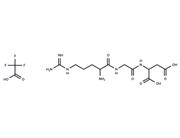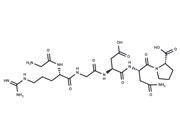| Name | Arg-Gly-Asp-Ser acetate |
| Description | Arg-Gly-Asp-Ser acetate is an integrin binding sequence that directly and specifically bind pro-caspase-8, pro-caspase-9 and pro-caspase-3, while it does not bind pro-caspase-1. Arg-Gly-Asp-Ser acetate inhibits integrin receptor function. |
| In vitro | The RGDS-modified surface caused up-regulation of alpha(v)beta(3) integrin. Attachment to the RGDS-treated membrane completely abolished apoptosis induced by staurosporine, the Ca(2+).P(i) ion pair, and sodium nitroprusside. When the activity of the phosphatidylinositol 3-kinase pathway was inhibited, RGDS-dependent resistance to apoptosis was eliminated. These results indicated that the binding of cells to RGDS abrogated apoptosis via the mitochondrial pathway and that the suppression of apoptosis was dependent on the activity of phosphatidylinositol 3-kinase. RGDS interacts with survivin, as well as with procaspase-3, -8 and -9.
Survivin, a known cell-cycle and survival-regulator is highly expressed in melanoma cells. RGDS-peptide binding to survivin was found to be specific, at high affinity (Kd 27.5 muM) and located at the survivin C-terminus. RGDS-survivin interaction appeared to play a key role, since RGDS lost its anti-mitogenic effect in survivin-deprived cells with a specific siRNA. |
| In vivo | Saline or LPS (1.5 mg/kg) was administered i.t. with or without a single dose of RGDS (1, 2.5, or 5 mg/kg, i.p.), anti-alphav or anti-beta3 mAb (5 mg/kg, i.p.). Mice were sacrificed 4 or 24 h post-LPS. |
| Storage | keep away from moisture | Powder: -20°C for 3 years | In solvent: -80°C for 1 year | Shipping with blue ice/Shipping at ambient temperature. |
| Solubility Information | DMSO : Slightly soluble
|
| Keywords | αVβ3 integrin | Arg-Gly-Asp-Ser Acetate | ArgGlyAspSer acetate | Arg Gly Asp Ser acetate |
| Inhibitors Related | K34c hydrochloride | E7820 | Arg-Gly-Asp TFA (99896-85-2(free base)) | Tirofiban hydrochloride monohydrate | Lifitegrast | Elarofiban TFA | Tirofiban | Bestatin hydrochloride | RO0270608 | ICAM-1-IN-1 | Cilengitide | Gantofiban |
| Related Compound Libraries | Apoptosis Compound Library | Bioactive Compound Library | Membrane Protein-targeted Compound Library | ReFRAME Related Library | Peptide Compound Library | Inhibitor Library | NO PAINS Compound Library | Bioactive Compounds Library Max |

 United States
United States






